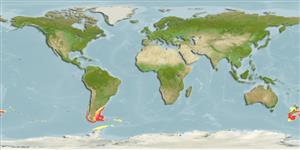>
Gadiformes (Cods) >
Gadidae (Cods and haddocks)
Etymology: Micromesistius: Greek, mikros = small + greek, mesos = middle + Greek, istion = sail (Ref. 45335).
More on author: Norman.
Environment: milieu / climate zone / depth range / distribution range
Ecologie
marien benthopelagisch; oceanodroom (Ref. 51243); diepte 50 - 900 m (Ref. 27363), usually 200 - 400 m (Ref. 7061). Temperate; 37°S - 65°S, 165°E - 34°W (Ref. 54589)
There are 2 disjunct populations. Micromesistius australis australis occurs around the Falkland Islands and Argentine Patagonia in the southwest Atlantic; off Chile in the southeast Pacific; also off South Georgia, South Shetland and South Orkney islands. Micromesistius australis pallidus occurs around the South Island of New Zealand.
Lengte bij maturiteit / Grootte / Gewicht / Leeftijd
Maturity: Lm 33.7, range 33 - 40 cm
Max length : 90.0 cm TL mannelijk / geslacht onbekend; (Ref. 1371); common length : 60.0 cm TL mannelijk / geslacht onbekend; (Ref. 1371); max. gepubliceerd gewicht: 850.00 g (Ref. 4883); max. gerapporteerde leeftijd: 30 Jaren (Ref. 7059)
Dorsale stekels (totaal) : 0; Dorsale zachte stralen (totaal) : 43 - 55; Anale stekels: 0; Anale zachte stralen: 56 - 71; Wervels: 54 - 57.
Invades shelf waters during summer and concentrating over the continental slope in winter. Forms schools (Ref. 9072). The young feed on euphausiids and amphipods and occasionally on copepods, cephalopods and small fish. Utilized in frozen blocks and as fishmeal. In Japan used as suerii (minced meat) for karaoke (fish cake) (Ref. 27363). Can be fried, microwaved and baked (Ref. 9988).
Oviparous, sexes are separate (Ref. 205).
Cohen, D.M., T. Inada, T. Iwamoto and N. Scialabba, 1990. FAO species catalogue. Vol. 10. Gadiform fishes of the world (Order Gadiformes). An annotated and illustrated catalogue of cods, hakes, grenadiers and other gadiform fishes known to date. FAO Fish. Synop. 125(10). Rome: FAO. 442 p. (Ref. 1371)
Status op de Rode Lijst van het IUCN (Ref. 130435)
Gevaar voor de mens
Harmless
Gebruik door de mens
Visserij: van groot commercieel belang
Tools
Speciale rapporten
Download XML
Internetbronnen
Estimates based on models
Preferred temperature (Ref.
123201): 3.4 - 9.1, mean 5.8 °C (based on 109 cells).
Fylogenetische diversiteitsindex (Ref.
82804): PD
50 = 0.7500 [Uniqueness, from 0.5 = low to 2.0 = high].
Bayesian length-weight: a=0.00372 (0.00223 - 0.00619), b=3.14 (2.99 - 3.29), in cm total length, based on LWR estimates for this species & (Sub)family-body (Ref.
93245).
Trofisch niveau (Ref.
69278): 3.8 ±0.50 se; based on food items.
Weerstandsvermogen (Ref.
120179): Gemiddeld, minimale populatieverdubbelingstijd 1,4-4,4 jaar (K=0.18; tm=2-5; tmax=30).
Prior r = 0.54, 95% CL = 0.36 - 0.82, Based on 5 data-limited stock assessments.
Fishing Vulnerability (Ref.
59153): Moderate to high vulnerability (52 of 100).
Climate Vulnerability (Ref.
125649): Moderate to high vulnerability (53 of 100).
Nutrients (Ref.
124155): Calcium = 38.2 [10.7, 99.6] mg/100g; Iron = 0.368 [0.123, 1.121] mg/100g; Protein = 16.3 [14.4, 18.6] %; Omega3 = 0.381 [0.149, 0.940] g/100g; Selenium = 12.1 [3.0, 42.1] μg/100g; VitaminA = 9.29 [1.98, 46.46] μg/100g; Zinc = 0.673 [0.286, 1.563] mg/100g (wet weight); based on
nutrient studies.
